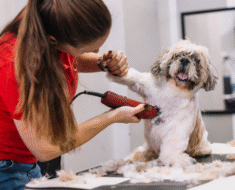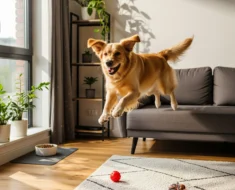If your dog barks, lunges, or gets anxious every time a bicycle or skateboard passes by, you’re not alone. This reaction can make walks stressful for both you and your furry friend.
But here’s the good news: you can change how your dog feels about these moving objects. Imagine peaceful walks where your dog stays calm and relaxed, no matter what’s rolling past. You’ll discover simple, effective steps to help your dog feel safe and comfortable around bicycles and skateboards.
Keep reading, and you’ll learn how to turn those tense moments into calm, happy ones.

Credit: www.reddit.com
Why Dogs React To Bicycles And Skateboards
Dogs often get scared or upset by bicyclesand skateboards. The noiseand quick movementmake them feel uneasy. Loud sounds can startle dogs, causing fear or anger.
Some dogs react more because of their breedor personality. Guard dogs may bark or chase. Smaller or shy dogs might hide or freeze. Each dog’s reaction depends on how they are naturally.
| Common Triggers | Details |
|---|---|
| Impact of Noise | Loud wheels or brakes scare dogs. |
| Movement | Fast, sudden motions cause alarm. |
| Breed Factors | Some breeds are more protective or nervous. |
| Personality | Shy dogs react differently than bold ones. |

Credit: www.familypupz.com
Preparing Your Dog For Desensitization
Start by watching your dog’s reactions to bicycles and skateboards. Note if they bark, chase, or hide. This helps to know how much training your dog needs.
Choose a quiet, open space for training. A park or a backyard works well. Make sure it is safe and free from distractions.
| Equipment | Purpose |
|---|---|
| Leash | Control your dog during training |
| Treats | Reward good behavior |
| Clicker (optional) | Mark positive responses |
| Bicycle or skateboard | Use for controlled exposure |
Step-by-step Desensitization Techniques
Start by showing your dog bicycles and skateboards from a distance. Keep the dog calm and relaxed. Slowly shorten the distance as your dog gets comfortable. Let your dog watch quietly without forcing interaction. This helps build positive feelings about the sight.
Use treats and praise to reward calm behavior. Give a treat when the dog stays quiet or looks away. This links good things with bicycles and skateboards. Repeat often to strengthen the positive connection.
Keep the initial exposures short. Gradually increase how long your dog sees the bicycle or skateboard. This prevents stress from building up. Stop if your dog shows fear or anxiety. Go back to a distance where your dog feels safe.
Raise the challenge slowly by adding faster or closer bicycles and skateboards. Always watch your dog’s comfort level. Use treats and calm voices to encourage. Avoid sudden moves or loud noises that might scare your dog.
Incorporating Counter-conditioning Strategies
Start by showing your dog bicycles and skateboards from a distance. Give treatsor praiseeach time they see one calmly. This builds a good feelingabout these objects.
Gradually bring the bicycle or skateboard closer over several days. Keep giving rewardsto keep the dog calm and happy. This helps reduce fearor excitement.
Practice in different places and with different riders. This strengthens the positive associationin many situations. Be patient and keep sessions short and fun.
Handling Setbacks And Challenges
Signs of stressin dogs include trembling, barking, or trying to run away. Watch your dog closely for these signals. They might also hide or refuse treats. Recognizing these signs early helps you avoid making your dog more scared.
Adjust your training speed to your dog’s comfort. Take small steps and repeat often. If your dog seems upset, slow down or take a break. Patience is key. Each dog learns at its own pace.
Sometimes, professional help is needed. Trainers can give advice tailored to your dog’s needs. They have tools and skills to manage tough cases. Don’t hesitate to ask for help if you feel stuck or overwhelmed.

Credit: phoenixdogtraining.com
Maintaining Progress Long-term
Consistent practicehelps keep your dog calm around bicycles and skateboards. Short, daily sessions work best. Always praise and reward good behavior to reinforce learning. Gradually increase the time and distance your dog stays calm.
Introduce your dog to different places where bikes and skateboards appear. This helps them get used to new sights and sounds without fear. Walk in parks, sidewalks, or quiet streets to build confidence.
Watch your dog’s reactions closely. Notice if they seem anxious or scared. Adjust your training speed to avoid stress. Celebrate small improvements and stay patient. This steady approach keeps progress steady and lasting.
Frequently Asked Questions
How Can I Safely Introduce My Dog To Bicycles?
Start by exposing your dog to stationary bicycles at a distance. Gradually decrease the distance while rewarding calm behavior. Use a leash and stay calm to build positive associations.
Why Do Dogs Fear Skateboards And Bicycles?
Dogs may fear these due to sudden movements, noise, or unfamiliar shapes. This triggers their natural flight or fight instincts, causing anxiety or aggression.
What Are Effective Desensitization Techniques For Dogs?
Use gradual exposure combined with positive reinforcement. Begin with distant, controlled encounters, reward calmness, and slowly increase exposure intensity to build confidence.
How Long Does Desensitizing Dogs To Bicycles Take?
Desensitization duration varies by dog, but consistent daily sessions over weeks are typical. Patience and gradual progress are key for lasting results.
Conclusion
Desensitizing dogs to bicycles and skateboards takes time and patience. Start slow and use treats to create positive feelings. Practice in quiet areas before trying busier places. Consistency helps dogs feel calm and safe around moving objects. Remember to praise your dog for good behavior.
Over time, your dog will stay relaxed and enjoy walks more. Stay patient and keep sessions short and fun. Small steps lead to big progress in dog training. Your efforts make walks safer for both of you.





